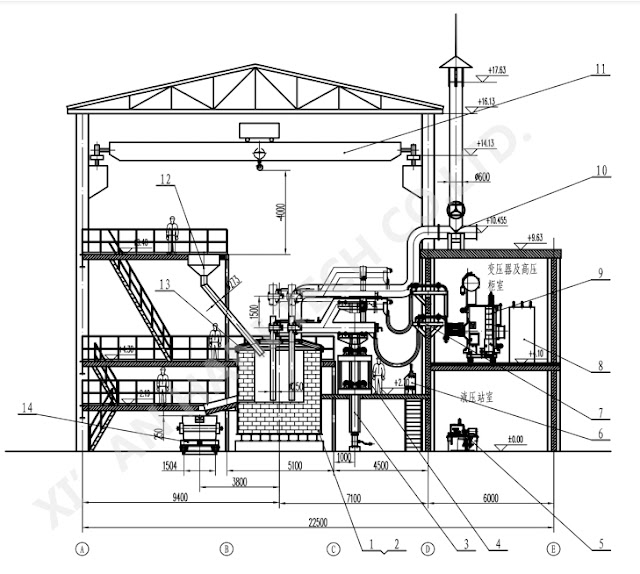Submerged Arc Furnace Diagram
The submerged arc furnace mainly produces ferrosilicon, ferromanganese, ferrochromium, ferrotungsten, silicon-manganese alloy and other ferroalloys, which are important industrial raw materials in the metallurgical industry and chemical raw materials such as calcium carbide.
The working characteristic of SAF is to use carbonaceous or magnesia refractory material as lining and use self-cultivation electrode.
The electrode is inserted into the charge for submerged arc operation, using the energy and current of the arc to pass through the charge, and generating energy due to the resistance of the charge to smelt metal.
Since the production of manganese-silicon alloy is carried out in submerged arc furnace, the slag method is usually used for smelting, and the distribution in the furnace during electric furnace smelting is mainly:
Charge zone (raw charge zone), semi-melting zone, melting zone, coke layer, slag layer, alloy layer, dead charge zone.
The mixture is added from the furnace mouth and begins to melt under the action of electric arc and current. When the primary slag generated during the melting process flows through the surface of the hot coke, it begins to be reduced by carbon to form fine alloy droplets. The reaction is mainly concentrated in the penetration of the primary slag. When passing through the coke layer, its reaction equation is:
Mn0+SiO2+3C=MnSi+3C0
The reacted slag and alloy converge at the bottom of the furnace and are divided into a slag layer and an alloy layer.
The submerged arc furnace diagram shown in the article is for your reference.
Submerged arc furnace diagram:
When smelting in submerged arc furnace, after the qualified silica, reducing agent and steel scrap are proportioned with electronic scale, the weighed charge is poured into the hopper. By belt or inclined bridge feeder
Into the furnace top silo, according to the demand of the charge, the charge can be directly added into the furnace from the material pipe connected under the silo (or added to the furnace by a feeder). small stove
Usually the charge is sent to the operating platform and manually added to the furnace.
The material surface of the furnace mouth should maintain a certain shape, the electrodes should be in the shape of a wide and flat cone, and the height of the cone should be 200-300mm. In order to adapt to the characteristics of concentrated heat and fast chemical materials in this area.
Feeding can be done by adding less work or in batches and concentrated feeding, and the deviation of feeding should be corrected in time. In order to maintain good air permeability in the furnace, it is necessary to dazzle and smash the furnace in time. It should be used in areas with poor air permeability (weak fire, hard material surface), in order to attract "stab fire" (furnace gas is ejected from around the electrode with a large pressure) area with serious dazzling, or according to the furnace conditions in the area. The blackened area or "stab fire" area of the large face and the lower part of the cone is stoked. Dazzling to be diligent, according to furnace conditions.
The small pounding furnace can be carried out according to the furnace conditions, and the large pounding furnace is generally carried out after the iron is tapped.
When the molten iron in the furnace accumulates to a certain amount, preparations for tapping should be made. Before tapping, tools and mud balls for opening and blocking furnace eyes should be prepared, and the ladle should be checked.
When tapping, first use round steel to remove residual flooding, residual iron and mud balls around the furnace hole with round steel, and then use round steel to open the furnace hole at the top of the center line of the furnace hole. When the tap hole is difficult to open, use The round steel is connected to the burn-through device and boiled.
The furnace eye should be large on the outside and small on the inside, in a circular shape. After the tap hole is opened, the size of the iron flow should be controlled to be appropriate, and the tap time should be controlled within 15 minutes.
After tapping, clean the tap hole, and use plugging material to block the tap hole.
After the iron is cast, it should be poured immediately to avoid cooling. When ferrosilicon is condensed, silicon crystallizes first, and floats up because of its low density, and iron silicide with high density sinks.
In order to reduce segregation, the pouring temperature of molten iron can be reduced, the thickness of the iron ingot can be reduced, and the cooling rate of the iron ingot can be accelerated. Usually, a shallow ingot mold with a depth of less than 100mm is used when pouring FeSi75.
After pouring, when the alloy ingot is condensed into cherry red, the alloy is lifted from the ingot mold with a crane and placed on the cooling table to cool.
The cooled alloy ingots are broken, the residues are removed, and the ingots are packaged and stored.
The above is about the content of the submerged arc furnace diagram. Welcome to my blog, I will continue to share about SAF, electric arc furnace, ladle refining furnace and other smelting equipment.
If you have any questions or needs, please feel free to contact me at any time.
E-mail: saleswn@hanrm.com / inquiry66@hanmetallurgy.com ( Daisy )
Xi'an Hani Tech Co.,Ltd.



Comments
Post a Comment